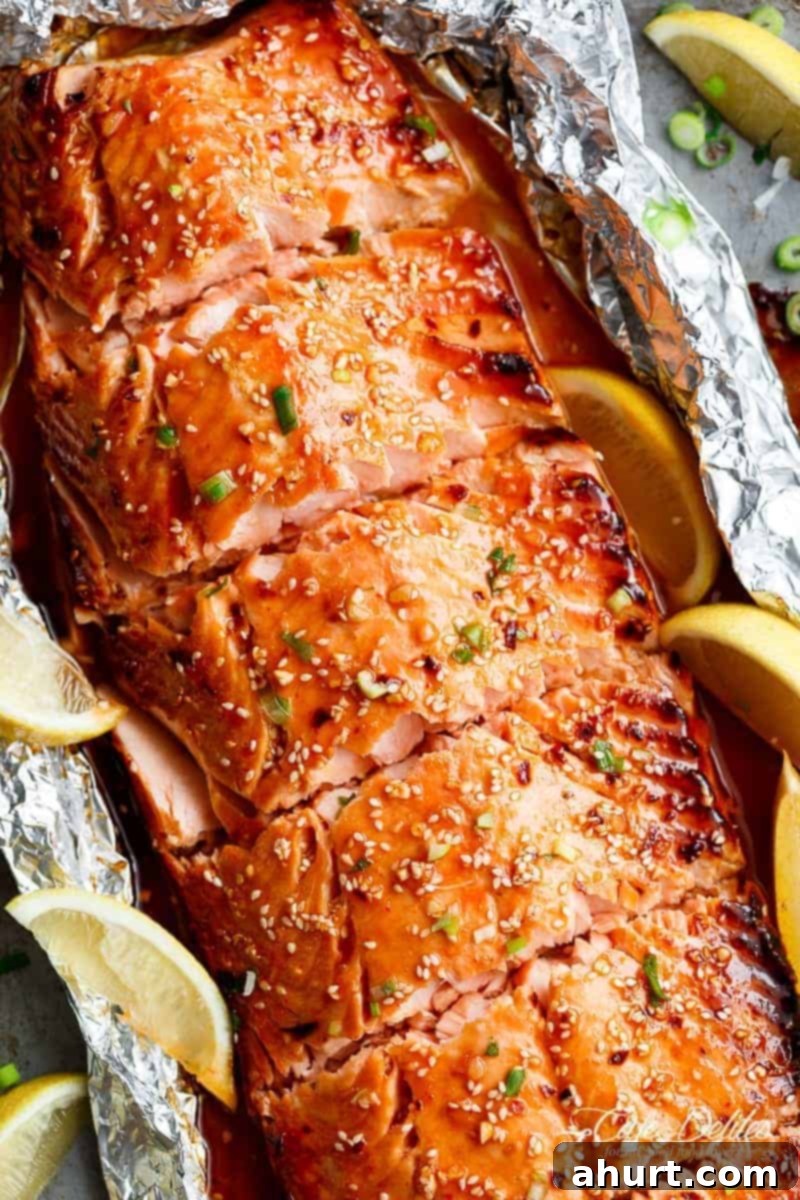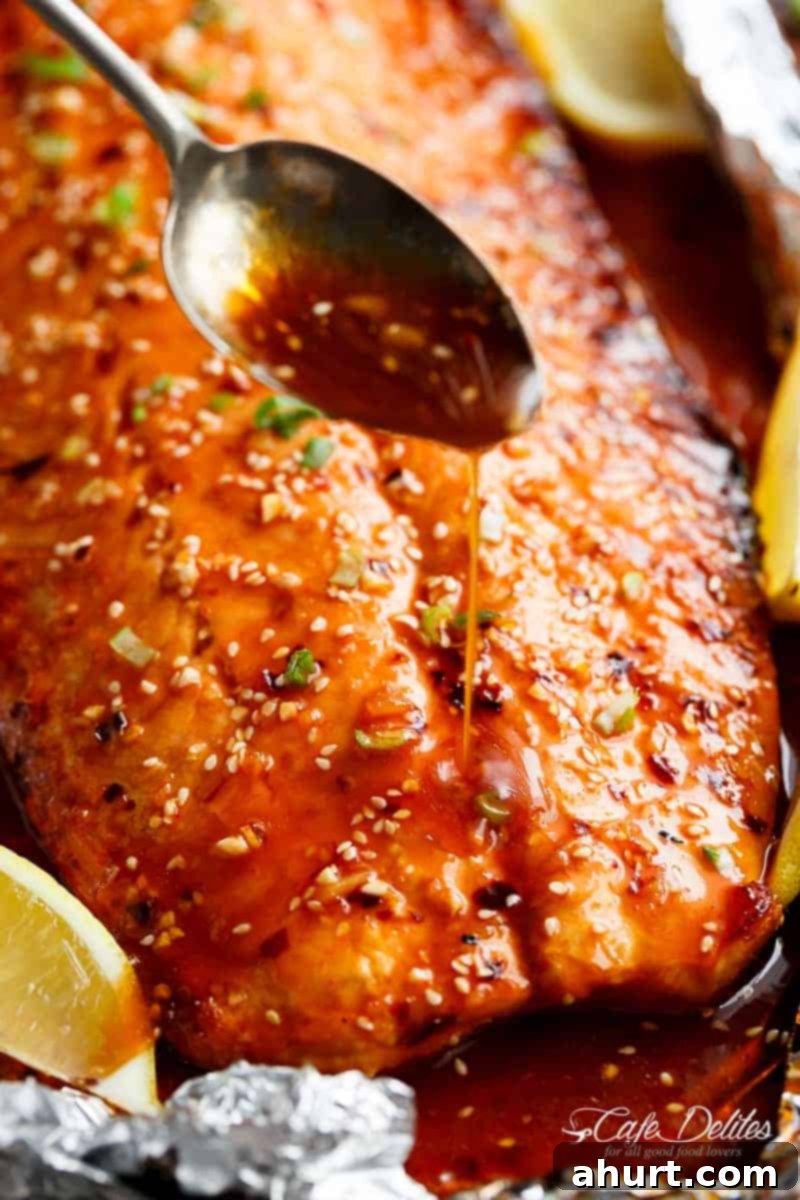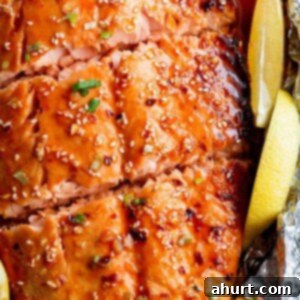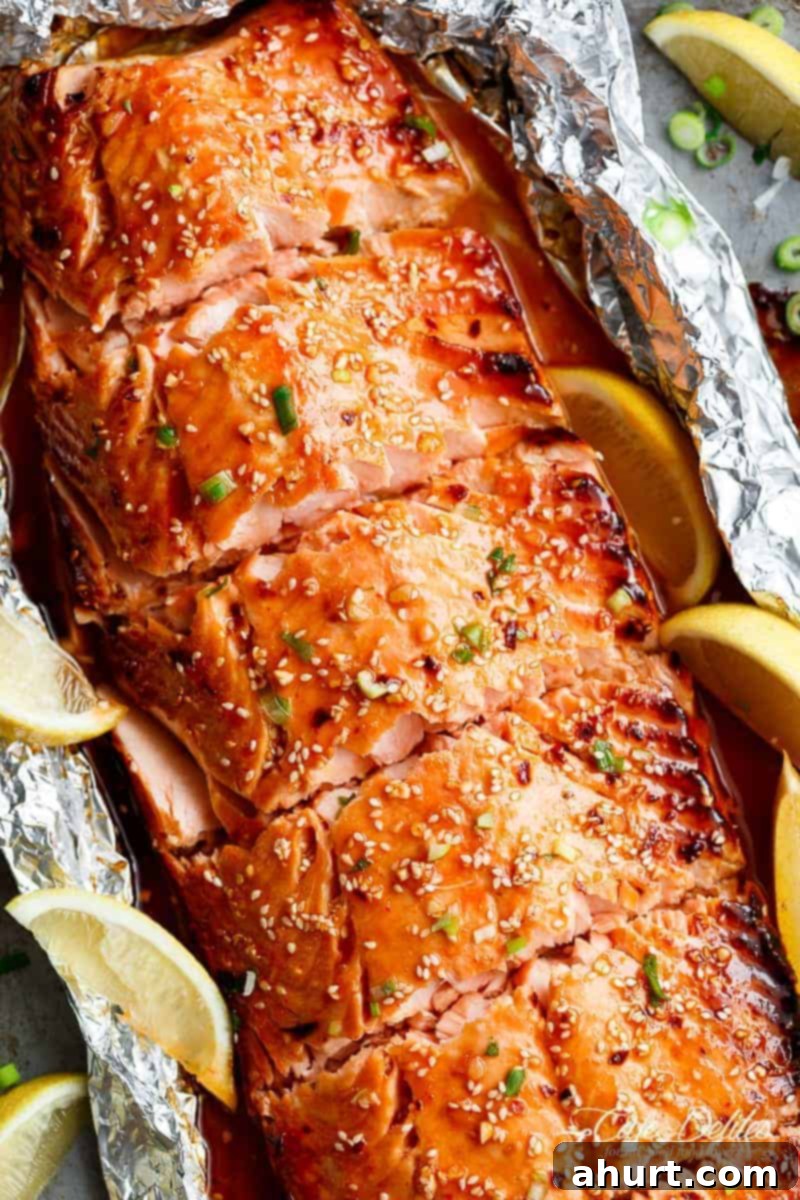Easy Honey Sesame Salmon in Foil: Your Go-To Weeknight Asian-Inspired Dinner
Imagine a delicious, restaurant-quality meal that’s ready in under 20 minutes, bursting with vibrant Asian-inspired flavors, and requires minimal cleanup. That’s exactly what you get with this incredible Sesame Salmon baked in foil. It’s the ultimate quick dinner solution, utilizing simple pantry ingredients you likely already have, proving that extraordinary taste doesn’t have to mean hours spent in the kitchen. If you’ve ever found yourself dreaming of a meal that delivers big on flavor without the usual fuss, then this recipe is about to become your new weeknight hero.
For those who adore the sweet and savory notes of Honey Sesame Chicken, prepare to fall head over heels for this delightful honey sesame salmon twist. The magic lies in its irresistible glaze: a perfect balance of sweetness from honey, savory depth from soy sauce, and a complex nutty aroma from toasted sesame. This glaze transforms tender, flaky salmon into a culinary masterpiece that’s both comforting and exciting. The genius of cooking this sesame glazed salmon in foil is the promise of minimal cleanup – a true game-changer that translates into more precious time enjoying your delicious dinner and less time scrubbing dishes. This method ensures the salmon remains incredibly moist and flavorful, every single bite.

The Magic of Foil Baking for Perfect Salmon
The secret behind this incredibly tender and flavorful salmon isn’t just the delicious glaze, but also the clever cooking method: baking in foil. This technique creates a steamy, self-contained environment that locks in moisture and infuses every flake of fish with the aromatic sesame honey sauce. As the salmon bakes, the foil packet acts like a mini oven, ensuring even cooking and preventing the fish from drying out, which is a common challenge with salmon. This results in a consistently tender, moist, and succulent fillet that practically melts in your mouth.
Beyond the superior texture, cooking in foil offers unparalleled convenience. It means no sticky pans to scrub, no splattered oven to clean, and virtually no mess at all. Simply wrap, bake, and then easily dispose of the foil. This makes it an ideal choice for busy weeknights when you want a healthy, impressive meal without the tedious cleanup. It’s a method that truly elevates your home cooking, making gourmet-quality fish accessible to everyone, even on the busiest of schedules.
Unlocking the Irresistible Flavors of Honey Sesame Salmon
This sesame salmon recipe is a masterpiece of balanced flavors, combining speed and simplicity with an explosion of taste. The foundation of its appeal is the harmonious blend of honey and soy sauce, which creates a perfect dance between sweet and salty. Honey lends a rich, natural sweetness that caramelizes beautifully, while soy sauce provides a deep, umami-rich savory backbone, enhancing the natural flavors of the salmon.
But the flavor journey doesn’t stop there. Toasted sesame oil is a crucial player, layering in a nutty depth and an unmistakably aromatic quality that instantly transports you to Asian culinary landscapes. Sesame seeds add a textural crunch and further amplify this distinctive nutty profile. Fresh garlic and ginger contribute bright, pungent notes, cutting through the richness and adding a zesty kick. A touch of Sriracha introduces a gentle warmth, which can be adjusted to your preference, and a hint of lemon juice or rice wine vinegar provides a much-needed acidic brightness, rounding out the complex flavor profile. The synergy of these ingredients, combined with the moist cooking in foil, ensures every bite of this honey sesame salmon is tender, flaky, and absolutely irresistible. It’s the ultimate weeknight win, delivering restaurant-quality flavor without the fuss, ready in less than 20 minutes from start to finish.
Essential Ingredients for Your Sesame Salmon
Crafting this delectable sesame salmon relies on a few simple pantry staples that come together to create a sweet, savory, and subtly spicy glaze, truly making the fish shine. Each ingredient plays a vital role in building the dish’s signature flavor profile.
- Honey: This natural sweetener is key to balancing the savory notes of soy sauce and the gentle heat from the Sriracha. It also aids in caramelization, giving the salmon a beautiful, slightly sticky finish under the broiler.
- Soy Sauce: The cornerstone of many Asian glazes, soy sauce brings a rich, salty, and umami depth that is essential for enhancing the inherent richness of the salmon. Regular soy sauce offers a robust saltiness, but a low-sodium version can be used if you’re mindful of sodium intake.
- Sesame Oil: Toasted sesame oil is a powerhouse of flavor, infusing the entire dish with its distinctive nutty aroma. It’s best added towards the end of the glaze preparation to preserve its delicate fragrance.
- Salmon: The star of the show! Opt for fresh, high-quality salmon fillets, ideally wild-caught, for the best flavor and texture. A skin-on fillet is often preferred as the skin helps protect the fish and keeps it even more moist during baking, though skinless fillets work perfectly fine too. Look for fillets that are vibrant in color and firm to the touch.
- Butter: Adds richness and helps emulsify the glaze, contributing to a smoother, more luxurious mouthfeel.
- Lemon Juice & Rice Wine Vinegar: These acidic components provide a crucial bright counterpoint to the sweet and savory elements, preventing the glaze from being overly heavy and adding a refreshing tang. Apple cider vinegar can be a good substitute for rice wine vinegar if needed.
- Garlic & Ginger: Freshly minced garlic and ginger are non-negotiable for that authentic Asian-inspired aromatic punch. They add a fresh, pungent zest that elevates the entire dish.
- Sriracha & Chili Flakes: Sriracha offers a gentle, adjustable heat, making the glaze more exciting. For those who love more spice, feel free to increase the amount. Red chili flakes are an optional addition for an extra visual and spicy kick.
- Sesame Seeds: Used both in the glaze and as a garnish, sesame seeds contribute a delightful crunch and intensify the nutty flavor.
Note: Please see the detailed recipe card at the bottom for a full list of ingredients with precise measurements.
How To Make Sesame Salmon
Creating this flavorful Honey Sesame Salmon in foil is incredibly straightforward, designed for efficiency without compromising on taste. Follow these simple steps for a perfect meal every time:
- Prepare Your Oven and Baking Tray: Start by positioning an oven rack in the middle. Preheat your oven to a steady 375°F (190°C). Then, line a sturdy baking tray with a large sheet of foil. Ensure the foil is generous enough to completely fold over and seal your salmon, creating a tightly enclosed packet. If your salmon fillet is particularly wide, you can overlap two long pieces of foil lengthwise to create a larger, more secure packet.
- Craft the Glaze Base: In a small saucepan, combine the honey, soy sauce, and butter. Place this over low to medium heat, whisking continuously. The goal here is to gently melt the honey and butter together, ensuring the mixture becomes smooth and well combined. This forms the rich, foundational sweetness and savory depth of your glaze.
- Complete the Flavorful Glaze: Once the base is smooth, remove the saucepan from the heat. This is crucial for preserving the integrity of the more delicate ingredients. Now, stir in the lemon juice, minced garlic, rice wine vinegar, Sriracha (adjust to your preferred spice level), sesame oil, minced ginger, sesame seeds, and a pinch of red chili flakes (if using). Whisk everything together thoroughly until all ingredients are well incorporated, creating a complex and aromatic glaze.
- Reserve Some Sauce for Serving: Before coating the salmon, transfer about 1/4 cup of this freshly made glaze into a small separate dish. This reserved sauce will be used later for drizzling over the cooked salmon, adding an extra layer of fresh, vibrant flavor and moisture just before serving. Set it aside.
- Season the Salmon Perfectly: Carefully place your salmon fillet onto the prepared foil-lined baking tray. Lightly season the salmon with salt. If your salmon still has skin, patting it dry before seasoning can help achieve a better, slightly crisper texture during the final broiling step, though it’s not strictly necessary for moisture retention in foil.
- Coat the Salmon with Glaze: Now, generously pour the remaining glaze (the larger portion from the saucepan) over the salmon fillet. Using the back of a spoon or a small spatula, spread the glaze evenly across the entire surface of the fish, ensuring every part is well coated to absorb maximum flavor during cooking.
- Seal and Bake for Tenderness: Carefully fold the edges of the foil over the salmon, completely sealing the packet tightly. Ensure there are no gaps where the sauce could leak out or steam could escape, as this is key to locking in moisture and flavor. Transfer the sealed packet to your preheated oven and bake for 12 to 15 minutes. The exact cooking time will depend on the thickness of your salmon fillet and your desired level of doneness. Salmon is typically cooked when it flakes easily with a fork.
- Broil for Caramelization and Serve: Once baked, carefully open the foil packet, being cautious of the escaping steam. Place the tray back under the broiler for 3 to 5 minutes. Keep a very close eye on it during this stage, as broilers vary greatly in intensity; the goal is to caramelize the top of the salmon and create a beautiful, slightly charred glaze without burning it. Once beautifully caramelized, spoon the reserved sauce generously over the salmon, garnish with fresh green onion slices, and serve immediately with lemon wedges for an added burst of freshness.
For a truly unforgettable meal that delights the senses, consider serving your Honey Sesame Salmon with a variety of complementary dishes. Alongside the proposed Browned Butter Shrimp Scampi, where nutty butter and garlicky shrimp create a decadent surf-and-surf pairing, you might also consider simple steamed jasmine rice to soak up the glorious sauce. Add Tortellini with Chunky Beef Sauce for a hearty, comforting contrast, or lighten things up with a fresh Asian-inspired cucumber salad. Round out your feast with Creamy Chicken and Broccoli Pumpkin Alfredo, or for a simpler vegetable side, roasted asparagus or steamed bok choy would beautifully complement the salmon’s flavors, offering a cozy, wholesome finish to your meal.
Customizing Your Honey Sesame Salmon
One of the best aspects of this Honey Sesame Salmon recipe is its versatility. You can easily adapt it to your taste preferences or dietary needs.
- Adjusting Spice Levels: The recipe calls for 2 teaspoons of Sriracha for a gentle heat. If you’re a fan of fiery flavors, feel free to double the Sriracha or add an extra pinch of red chili flakes to the glaze. For a completely mild version, simply omit the Sriracha and chili flakes.
- Adding Vegetables: For a complete one-pan meal, you can add quick-cooking vegetables directly into the foil packet with the salmon. Think thinly sliced bell peppers, snap peas, broccoli florets, or even a handful of baby spinach. Just ensure they are cut small enough to cook through in the salmon’s baking time.
- Gluten-Free Option: To make this recipe gluten-free, simply substitute regular soy sauce with a certified gluten-free tamari. Most other ingredients are naturally gluten-free, but always check labels.
- Alternative Sweeteners: While honey offers a unique flavor, maple syrup or agave nectar could be used as a substitute if honey is unavailable, though the taste profile will shift slightly.
Frequently Asked Questions (FAQ)
The amount of Sriracha used in this recipe is designed to add a gentle hint of heat, making it mild and palatable for most. If you prefer a more pronounced spiciness, you can easily double the amount of Sriracha in the glaze or sprinkle extra red chili flakes before baking. For a completely non-spicy version, simply omit the Sriracha and chili flakes entirely.
Sesame oil is a key ingredient for its distinctive nutty aroma, which is a hallmark of this dish. If you don’t have it on hand, you could use peanut oil or a light olive oil as an alternative in the glaze. However, be aware that you will miss some of that rich, toasted nutty flavor that sesame oil provides, and the overall taste profile will be slightly different.
Absolutely, skinless salmon fillets work perfectly fine for this recipe. While skin-on salmon can sometimes help keep the fish incredibly moist and flavorful during baking, especially if you plan to crisp the skin under the broiler, skinless fillets will still cook beautifully in the foil packet and absorb all the delicious glaze. Adjust cooking time slightly if your skinless fillets are thinner.
Salmon is typically cooked when it reaches an internal temperature of 145°F (63°C) at its thickest part. Visually, it should flake easily with a fork and turn opaque throughout. Avoid overcooking, as this can lead to dry salmon. The 12-15 minute baking time is a good general guideline, but always consider the thickness of your specific fillets.


Easy Honey Sesame Salmon In Foil
Karina
15
15
30
8
Ingredients
- 1/3 cup honey
- 3 tablespoons regular soy sauce
- 2 tablespoons butter
- 2 tablespoons lemon juice freshly squeezed, juice of ½ a lemon
- 1 tablespoon garlic or 4 garlic cloves, crushed
- 1 tablespoon rice wine vinegar or apple cider vinegar
- 2 teaspoons Sriracha increase to 4 teaspoons if you like spicy
- 2 teaspoon sesame oil
- 1 teaspoon ginger minced
- 1 tablespoon sesame seeds
- 1 pinch red chili flakes optional
- 2-3 pound side of salmon wild caught, if possible
- 1 pinch salt to season
- 1 pinch green onion sliced to garnish
Instructions
-
Position a rack in the middle of the oven. Preheat oven to 375°F | 190°C. Line a baking tray / sheet with a large piece of foil, big enough to fold over and seal to create a packet (or 2 long pieces of foil overlapping each other lengthways to create your salmon packet, depending on the width of your fillet).
-
In a small saucepan, combine the honey, soy sauce and butter over low-medium heat, and whisk until the honey has melted through the butter and the mixture is well combined. Take off the heat, and add in the lemon juice, garlic, vinegar, Sriracha, sesame oil, ginger, sesame seeds and chili flakes. Transfer 1/4 cup of sauce into a small dish for serving later; set it aside.
-
Place the salmon onto prepared baking tray | sheet and season with salt (about 1 teaspoon — adjust to your taste). Pour the honey sesame mixture (from the pan) over the salmon, and spread evenly with the back of a spoon or spatula to evenly cover in sauce.
-
Fold the sides of the foil over the salmon to cover and completely seal the packet closed to prevent the sauce from leaking.
-
Bake until cooked through (about 12-15 minutes, depending on the thickness of your fish and your preference of doneness). Open the foil, being careful of any escaping steam, and grill / broil under the grill / broiler for 3-5 minutes on medium heat to caramelise the top (keep your eye on it so it doesn’t burn). Pour the reserved sauce over the salmon and garnish with green onion slices. Serve immediately with lemon wedges.
Notes
If you don’t have access to rice wine vinegar, you can use apple cider or regular white vinegar as alternatives — or leave it out entirely if absolutely necessary.
We find 2 teaspoons of Sriracha enough to give the sauce a subtle hint of heat. For a spicier sauce, add more to suit your taste! Or leave it out for a non-spicy version. (The chili flakes are also optional, for an extra kick).
Keep your eyes on the oven while your salmon is broiling. If your broiler is set too high, or if the salmon is placed too close to the broiler, the glaze can quickly burn. Please BE CAREFUL and do not leave it unattended.
Nutrition
Carbohydrates: 13g |
Protein: 24g |
Fat: 12g |
Saturated Fat: 3g |
Polyunsaturated Fat: 4g |
Monounsaturated Fat: 4g |
Trans Fat: 0.1g |
Cholesterol: 70mg |
Sodium: 482mg |
Potassium: 594mg |
Fiber: 0.2g |
Sugar: 12g |
Vitamin A: 140IU |
Vitamin C: 3mg |
Calcium: 29mg |
Iron: 1mg
Nutrition information is automatically calculated, so should only be used as an approximation.
Tried this? Leave a comment below!
